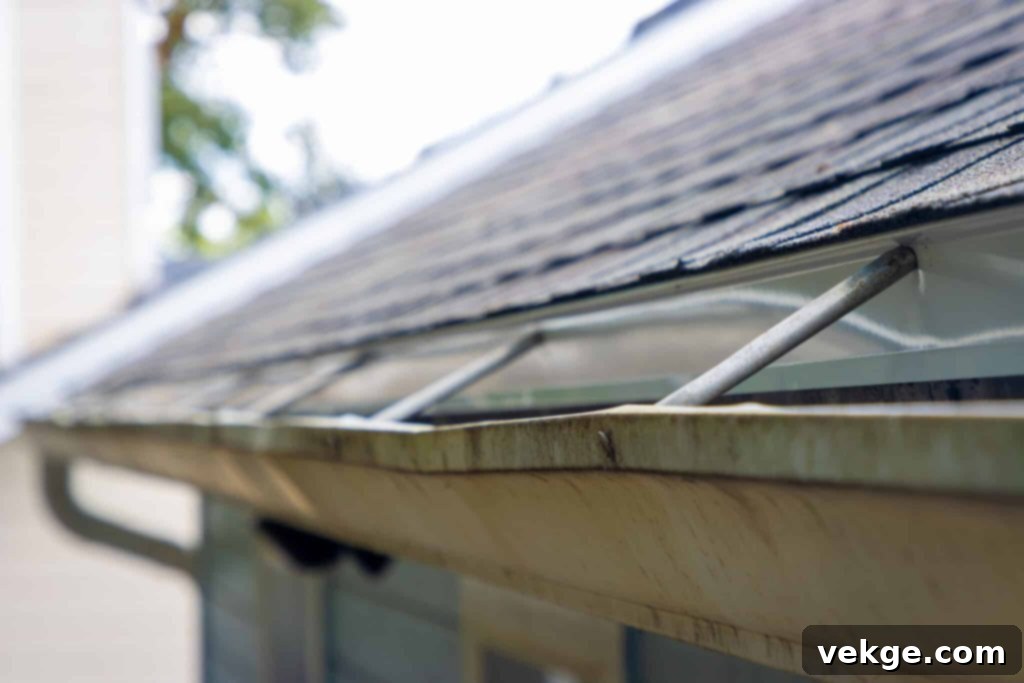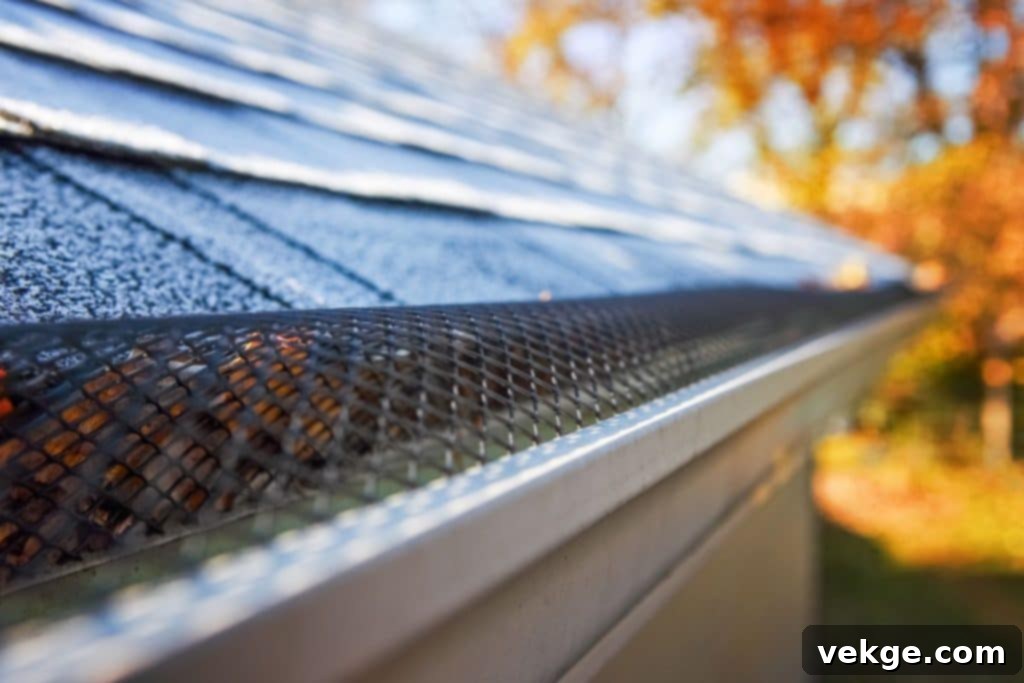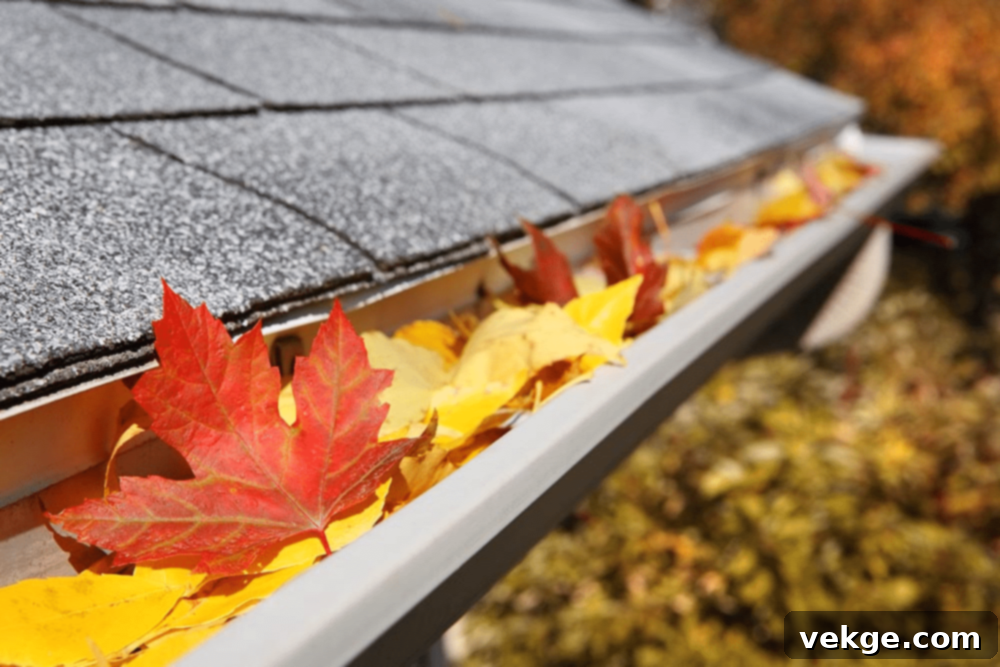Ultimate Guide to Gutter Maintenance: Protect Your Home & Roof
Maintaining your home’s gutters in prime condition is not just about keeping things tidy; it’s a critical aspect of efficient water drainage and the overall structural integrity of your roof and foundation. Gutters play a vital role in channeling rainwater away from your house, preventing costly damage such as foundation cracks, basement flooding, fascia rot, and landscape erosion.
Despite their importance, many homeowners face significant challenges with gutter maintenance. These can range from ensuring personal safety while working on ladders at height to tackling persistent issues like rust, blockages, and overflows. Neglecting these problems can lead to a cascade of expensive repairs and diminish your home’s value.
This comprehensive guide will equip you with the essential knowledge and practical tips needed to overcome these common gutter challenges. By following our advice, you can safeguard your home from water damage, significantly prolong the life of your gutter system, and ensure your property remains a safe and well-maintained sanctuary. Read on to master the art of effective gutter care.
Prioritize Safety: Wear Protective Gear

Your safety should always be the top priority when performing gutter maintenance. The work often involves ladders, sharp debris, and potential exposure to bacteria or mold. Wearing the appropriate protective gear is non-negotiable and ensures you remain safe from cuts, scrapes, eye injuries, and slips.
- Heavy-Duty Gloves: Essential for protecting your hands from sharp edges, rusty metal, splinters, and unpleasant debris like wet leaves, mud, and even animal droppings. Look for gloves with good grip and puncture resistance.
- Sturdy Footwear with Good Traction: Crucial for maintaining secure footing on ladder rungs, especially if they become wet or dirty. Opt for work boots or shoes with non-slip soles and ankle support to prevent twists and falls. Avoid open-toed shoes or sandals.
- Eye Protection: Goggles or prescription safety glasses are vital to shield your eyes from dust, small particles, twigs, and insects that can fall from the gutters or be splashed during flushing. An eye injury can be severe and easily preventable.
- Long-Sleeved Shirt and Long Pants: Protect your arms and legs from scratches, scrapes, and irritants found within the gutters or on the roof edge. Old clothes are often preferred as they are likely to get dirty.
- Head Protection (Optional but Recommended): A hard hat or bump cap can offer additional protection against accidental bumps from the ladder, roof edge, or low-hanging branches, especially if working in areas with overhead obstructions.
By taking a few moments to properly suit up, you significantly reduce the risk of injury and make the task of gutter cleaning much safer and more comfortable.
Master Ladder Safety
Working at heights carries inherent risks, and ladder accidents are a common cause of home maintenance injuries. Proper ladder usage is paramount for your safety during gutter maintenance:
- Inspect and Stabilize: Before climbing, always thoroughly inspect your ladder for any damage, loose rungs, or faulty mechanisms. Ensure it is placed on a firm, level surface. If the ground is uneven, use leveling tools or secure blocks. Never place a ladder on unstable objects like boxes or chairs.
- Maintain the 4-to-1 Rule: For extension ladders, the base should be placed one foot away from the wall for every four feet of height the ladder reaches. This angle provides optimal stability. The top of the ladder should extend at least three feet above the edge of the roof or gutter.
- Three Points of Contact: Always maintain three points of contact (two hands and one foot, or two feet and one hand) with the ladder at all times. This ensures stability and reduces the risk of falling.
- Never Overreach: Resist the temptation to stretch or lean too far to reach a distant section of the gutter. Instead, descend and reposition the ladder as necessary. Overreaching shifts your center of gravity and can cause the ladder to tip. Your belt buckle should always remain between the ladder rails.
- Engage a Spotter: Having another person hold the base of the ladder for you provides an invaluable layer of safety, especially on taller ladders or in slightly windy conditions. They can stabilize the ladder and alert you to potential hazards.
- Avoid the Top Rungs: Never stand on the top two rungs of an extension ladder or the top cap/top step of a stepladder. These areas are not designed for standing and can lead to instability.
- Weather Awareness: Avoid using ladders in high winds, heavy rain, or icy conditions. These elements drastically increase the risk of a slip or fall.
Adhering to these fundamental ladder safety guidelines will help prevent accidents and make your gutter cleaning routine much safer.
Choose the Proper Tools for Efficiency

Equipping yourself with the right tools can transform gutter maintenance from a dreaded chore into a manageable task. Proper tools not only make the job easier but also safer and more effective:
- Sturdy, Extendable Ladder: As discussed, a reliable ladder is paramount. Ensure it’s tall enough for your roofline and stable. Fiberglass ladders are often preferred for their non-conductive properties, making them safer around electrical wires.
- Gutter Scoop: This specialized tool, often made of plastic, is designed to fit the curve of your gutters, making debris removal much easier and less messy than using your hands (even with gloves). Some scoops feature extended handles for reaching further.
- Garden Hose with a Pressure Nozzle: Essential for flushing out smaller debris, rinsing the gutters clean after manual removal, and checking for proper drainage. A strong, adjustable nozzle helps dislodge stubborn grime.
- Gutter Vacuum: For those seeking a safer, ground-level cleaning solution, a gutter vacuum (often an industrial wet/dry vac with long extension poles and specialized nozzles) is an excellent investment. It allows you to remove leaves, dirt, and even standing water from the safety of the ground, eliminating the need for a ladder in many cases.
- Bucket or Tarp: Keep a bucket handy to collect the scooped-out debris. Alternatively, lay a tarp on the ground below your work area to catch falling debris, making cleanup much easier.
- Small Trowel or Stiff Brush: Useful for dislodging packed-down mud, shingle grit, or stubborn clumps of debris that a scoop might miss.
- Telescoping Pole with Attachments: Various attachments, such as hooks or brushes, can be added to a telescoping pole to extend your reach and clean parts of the gutter without constantly moving the ladder.
Investing in quality tools streamlines the process, reduces physical strain, and contributes to a more thorough and efficient gutter cleaning experience.
Prevent and Treat Gutter Rust
Rust is a common enemy of metal gutters, particularly those made from galvanized steel or older aluminum. It occurs when moisture and oxygen react with metal, leading to corrosion. Rust weakens the gutter structure, compromises its integrity, and can lead to leaks, unsightly stains on your home’s siding, and premature failure of the system.
Causes of Gutter Rust:
- Standing Water: The most significant contributor. Clogged gutters prevent water from draining, allowing it to sit and accelerate the rusting process.
- Scratches and Abrasion: Damage to the gutter’s protective coating exposes the raw metal to the elements.
- Acidic Debris: Decaying leaves and pine needles can become acidic when wet, creating a corrosive environment within the gutter.
- Age and Wear: Over time, any protective coatings wear down, making older gutters more susceptible to rust.
Prevention Strategies:
The best defense against rust is proactive prevention. You can prevent rust by implementing regular inspections and maintenance:
- Regular Cleaning: Keep your gutters free of debris to ensure proper drainage and prevent standing water. This is the single most effective way to prevent rust.
- Proper Installation: Ensure gutters are installed with a slight slope (about 1/4 inch per 10 feet) towards the downspouts to facilitate complete water runoff.
- Material Choice: If installing new gutters, consider rust-resistant materials like aluminum (which forms a protective oxide layer), copper (which develops a protective patina), or high-quality vinyl. Galvanized steel gutters should have a robust protective coating.
- Protective Coatings: For existing metal gutters, apply rust-inhibiting primers and paints specifically designed for exterior metal surfaces.
Treating Existing Rust:
If you’ve already noticed rust, act quickly to prevent it from spreading and causing further damage:
- Clean Thoroughly: Remove all debris and thoroughly clean the rusted area with a wire brush or sandpaper to get rid of loose rust flakes and prepare the surface.
- Apply Rust Converter: For minor rust, a rust converter product can chemically transform rust into a stable, paintable surface.
- Prime and Paint: Apply a rust-inhibiting primer, followed by two coats of exterior metal paint that matches your gutters.
- Replace Severely Rusted Sections: In cases of severe, widespread rust or perforations, replacing the rusted sections of the gutter or downspout is often the most durable solution.
Early detection and prompt action are key to managing gutter rust and extending the life of your system.
Address Sagging Gutter Issues Promptly

Sagging gutters are a visually unappealing and functionally problematic issue that can severely impede proper water drainage, leading to potential damage to your home’s fascia, siding, and foundation. This common problem often results from a combination of factors:
- Improper Installation: Gutters not installed with adequate support or proper slope from the outset.
- Heavy Debris Accumulation: Over time, gutters filled with wet leaves, mud, and twigs become excessively heavy, pulling them away from the fascia.
- Ice Dams: In colder climates, ice and snow accumulation can add significant weight, bending or detaching gutters.
- Worn or Damaged Hangers: Gutter hangers, brackets, or spikes can weaken, rust, or pull out of the fascia board due to age, wear, or excessive weight.
- Rotten Fascia Board: If the wood fascia board to which the gutters are attached is rotten or damaged, it won’t be able to hold the gutter hangers securely, leading to sagging.
Steps to Fix Sagging Gutters:
Addressing sagging gutters requires careful inspection and repair:
- Inspect the Fascia Board: Before attempting to re-secure gutters, carefully check the fascia board behind them. If it’s soft, crumbling, or shows signs of rot, it must be repaired or replaced first. Attaching gutters to rotten wood will only lead to recurring sagging.
- Check and Replace Gutter Hangers: Identify any loose, bent, or missing gutter hangers. Replace damaged hangers with new, stronger ones. Ensure they are evenly spaced (typically every 2-3 feet) and securely fastened into solid wood on the fascia. Different types of hangers (e.g., hidden hangers, K-style hooks) offer varying levels of support.
- Ensure Proper Slope: Gutters need a slight downward slope towards the downspouts to allow water to drain efficiently. The ideal slope is about 1/4 inch for every 10 feet of gutter length. Use a level and a string line to determine the current slope and adjust the hangers as needed to achieve the correct pitch. You may need to loosen and re-tighten hangers to raise or lower sections.
- Regular Cleaning: To prevent future sagging, commit to regular gutter cleaning. Removing debris prevents excessive weight from accumulating, which is often the primary cause of hangers failing and gutters sagging.
By systematically addressing these points, you can effectively fix sagging gutters, restore proper water flow, and prevent further damage to your home’s exterior.
Implement Strategies to Avoid Gutter Overflows
Overflowing gutters are a clear sign of a malfunctioning drainage system and can wreak significant havoc on your home’s foundation, landscaping, and exterior. When gutters overflow, water is dumped directly at your home’s base, leading to a host of expensive problems:
- Foundation Damage: Prolonged saturation of the soil around your foundation can lead to hydrostatic pressure, causing cracks in the foundation walls and potentially basement leaks.
- Erosion and Landscape Damage: Overflowing water can wash away topsoil, damage plants, and create unsightly trenches in your yard.
- Fascia and Soffit Rot: Water spilling over the gutter edge can saturate the fascia board, leading to wood rot, mold growth, and attracting pests.
- Siding Stains: Dirty water continuously running down the siding can leave permanent stains, especially on lighter-colored materials.
- Ice Dams (in winter): In colder climates, overflowing water can refreeze on eaves and sidewalks, creating dangerous ice dams and slippery conditions.
Fortunately, this common problem is largely preventable with a few proactive measures:
- Regular Gutter Cleaning: This is the most crucial step. Gutters become clogged with leaves, twigs, shingle grit, pine needles, and other debris, especially during fall and spring. A clogged gutter cannot effectively channel water away, causing it to pool and eventually overflow. Aim to clean your gutters at least twice a year, or more frequently if you have many trees nearby.
- Check and Clear Downspouts: Even if the main gutter channel is clear, a blocked downspout will prevent water from exiting the system, leading to immediate overflow. Use a garden hose with a strong nozzle to flush out downspouts. If a blockage persists, you may need a plumber’s snake or to temporarily detach the downspout to clear it.
- Ensure Proper Gutter Slope: As mentioned, gutters need a slight pitch towards the downspouts to facilitate continuous water flow. If sections are level or sloped incorrectly, water will pool, contributing to clogs and overflows.
- Consider Gutter Extensions and Splash Blocks: Ensure downspouts direct water far enough away from your foundation (at least 5-10 feet). Downspout extensions or splash blocks can help achieve this, preventing water from pooling near the house.
- Install Gutter Guards: While not a complete maintenance solution, gutter guards significantly reduce the amount of debris entering your gutters, thereby reducing the frequency of clogs and potential overflows. (More on this in the next section).
By diligently applying these preventive measures, you can avoid the headache and expense associated with overflowing gutters and ensure your home remains protected.
Maximize Gutter Guards’ Role in Your Gutter System

Gutter guards are a popular addition for homeowners looking to reduce the frequency and intensity of gutter cleaning. While no gutter guard eliminates maintenance entirely, they significantly minimize the amount of debris that enters your gutters, thereby preventing many clogs and extending the periods between cleanings.
When choosing the best gutter guards for your home, several factors come into play, primarily the type of debris common in your area, your local climate, and your budget. Here’s a breakdown of common types:
- Mesh Guards: These covers feature a screen or mesh over the gutter opening, allowing water through while blocking most solid debris.
- Pros: Effective against a wide range of debris, including small leaves and pine needles. Available in various materials (aluminum, stainless steel) and mesh sizes. Relatively affordable.
- Cons: Fine mesh can sometimes clog with shingle grit or pollen, requiring surface cleaning. Larger mesh might let smaller debris through.
- Best For: Homes with moderate tree cover, particularly good for pine needles.
- Reverse Curve (Surface Tension) Guards: These guards are designed with a curved nose that extends past the gutter, allowing water to cling to the surface and flow into the gutter while leaves and debris fall over the edge.
- Pros: Highly effective at shedding larger debris like leaves. Low maintenance once installed.
- Cons: Can be expensive. May not perform as well with heavy rainfall or fine debris like pine needles. Can be visible from the ground, altering the roofline appearance.
- Best For: Homes with significant deciduous tree cover and heavy leaf fall.
- Foam Guards: These are sections of foam inserted directly into the gutter, filling the space while allowing water to filter through.
- Pros: Budget-friendly and very easy to install (DIY-friendly). Effectively block large debris.
- Cons: Can degrade over time due to UV exposure. May eventually clog with shingle grit, seeds, or fine debris, requiring removal and cleaning. Can promote moss growth in shaded, damp areas.
- Best For: Homeowners on a budget or those looking for a quick, temporary solution.
- Brush Guards: Essentially a large pipe cleaner inserted into the gutter, the bristles catch debris while allowing water to pass through.
- Pros: Easy to install and remove for cleaning. Blocks large debris.
- Cons: Can become clogged with smaller debris or seeds lodged within the bristles. Requires periodic removal and cleaning.
- Best For: Areas with larger debris and homeowners who don’t mind periodic brush cleaning.
When making your selection, consider your specific environmental factors. While gutter guards reduce cleaning frequency, regular inspections are still recommended to ensure they remain clear and functional, especially after severe weather. No system is truly “maintenance-free.”
Optimize Cleaning Frequency and Timing
Understanding how often and when to clean your gutters is crucial for maintaining an effective drainage system and preventing costly damage. While a general rule exists, your specific environment will dictate the optimal schedule.
How Often Should Gutters Be Cleaned?
Generally, cleaning your gutters twice a year is a good practice for most homes. This allows you to clear out accumulated debris before the heaviest rainfall seasons or winter snows begin.
However, you might need to clean your gutters more frequently if:
- You Have Large, Overhanging Trees: Homes surrounded by mature deciduous or evergreen trees (like oaks, maples, or pines) will accumulate leaves, seeds, and needles much faster. In such cases, quarterly cleanings (every three months) or even more often might be necessary.
- Pine Trees are Nearby: Pine needles are particularly problematic as they are small, numerous, and can easily bypass some gutter guards, leading to stubborn clogs.
- Heavy Shingle Grit: Older roofs or those exposed to high winds can shed more shingle granules, which accumulate and form sludge in gutters.
- Extreme Weather: After severe storms, high winds, or heavy rains, it’s wise to perform a quick inspection and potentially a cleaning to clear any sudden debris.
- Visible Signs of Clogging: If you notice water overflowing, plants growing in your gutters, or visible debris, it’s time for a cleaning regardless of your schedule.
The Best Times for Cleaning:
Timing your gutter cleanings with seasonal changes can maximize efficiency and effectiveness:
- Late Spring (After Pollen and Seed Shed): This is an ideal time to clear out debris from spring blooms, such as pollen, seed pods, tree flowers, and any residual winter grime. Cleaning in late spring ensures your gutters are ready for summer thunderstorms.
- Early Fall (After Peak Leaf Drop): This is arguably the most critical cleaning period. Wait until most of the leaves from deciduous trees have fallen (typically late October to mid-November, depending on your climate). Clearing these leaves before winter’s first freezes or heavy rains prevents massive clogs, potential ice dams, and excess weight on your gutters.
By tailoring your cleaning frequency and timing to your home’s specific environment, you can ensure your gutters remain clear and functional year-round, protecting your home from water damage.
Don’t Hesitate to Call Professionals
While many gutter maintenance tasks can be handled by diligent homeowners, there are specific situations where calling in the professionals is not just convenient, but essential for safety, effectiveness, and long-term protection of your home.
When to Engage Professional Gutter Services:
- Height and Safety Concerns: If your home is multi-story, has a steep roof pitch, or if you are uncomfortable working on ladders, professional help is invaluable. They have the proper safety equipment, training, and insurance to perform the job safely.
- Significant Rust and Damage: As previously mentioned, if you spot widespread rust in your gutters, significant sections that are severely corroded, or signs of structural damage beyond a simple repair, it’s vital to get expert help. Professionals can accurately assess the extent of the damage, treat severe rust, and perform necessary replacements to prevent leaks and structural weakening.
- Persistent Overflows and Clogs: If you’re consistently dealing with overflowing gutters despite regular DIY cleaning, there might be a deeper issue, such as an incorrect slope, hidden downspout blockages, or undersized gutters. Professionals can diagnose and rectify these underlying problems. Ignoring persistent overflow will undoubtedly lead to severe damage to your home’s foundation and ruin your landscaping.
- Gutter Guard Installation: While some gutter guards are DIY-friendly, certain types (especially high-end mesh or reverse-curve systems) require precise installation to function correctly and avoid voiding roof warranties. Professionals ensure a seamless fit and optimal performance.
- Gutter Installation or Replacement: Installing new gutters or replacing an entire system is a complex job that requires specialized tools, knowledge of proper sizing, sloping, and seamless construction. Professional installation ensures your gutters are correctly fitted, watertight, and durable.
- Fascia Board Damage: If you suspect the fascia board (the wood behind your gutters) is rotten or damaged, it’s a structural issue that should be addressed by professionals to ensure proper reattachment and long-term stability of your gutters.
- Time Constraints or Lack of Expertise: If you simply don’t have the time, physical ability, or confidence to perform thorough gutter maintenance, hiring professionals is a practical solution. Their expertise ensures the job is done right, saving you potential headaches and costs down the line.
Professionals offer peace of mind, expert solutions, and often warranties on their work. While there’s a cost involved, it’s an investment in your home’s longevity and your family’s safety, potentially preventing much larger expenses from water damage in the future.
And there you have it – the comprehensive lowdown on keeping your gutters in fighting shape. It might not be the most glamorous home maintenance task, but think of it this way: every scoop of debris cleared, every hanger secured, and every downspout flushed is a proactive step away from costly water damage disasters. Your gutters are your home’s first line of defense against the elements, tirelessly diverting thousands of gallons of water away from your foundation and roof structure.
So, suit up with your protective gear, embrace the ladder (safely, of course), and show those gutters some regular love. Whether you’re preventing rust from cropping up, fixing a sag like a tired smile, or tackling a persistent overflow, these are your cues to either get down and DIY with confidence or give the pros a call for expert assistance. Proactive gutter maintenance is all about keeping your home happy, dry, looking sharp, and maintaining its value for years to come. Don’t underestimate its power!
